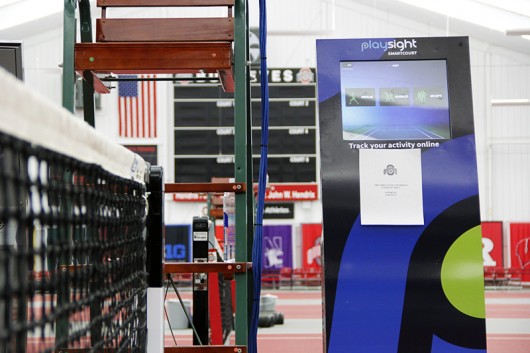
PlaySight’s SmartCourt technology will provide players and coaches with video analysis on everything that happens during practices and matches.
Credit: Matt Wilkes | Senior Lantern reporter
The Ohio State men’s and women’s tennis teams have gone a combined 15-1 this season — earning national rankings of No. 8 and No. 16, respectively — and they might have just gotten another leg up on the competition.
In January, the OSU Varsity Tennis Center had PlaySight’s SmartCourt technology installed on two of its courts, providing players and coaches with video analysis on everything that happens during practices and matches.
Using six cameras and a courtside kiosk, players can run drills or play a match and instantly receive feedback on their game through video and various statistics tracked by the system. If they’re not at the tennis facility, they can also access the information through their phones and laptops at any time and place.
“One of the great features is that it automatically tags every event that’s happening on the court,” said Josh Graves, PlaySight’s sales manager for North America. “That means that the system, through image processing and sophisticated algorithms that are running on a computer … is able to determine whether you’re hitting a forehand crosscourt winner or a backhand slice to the net or a first-serve ace.”
From there, if a player wants to see all of his or her aces or backhands, a video package can be grouped together to view just that. The technology also has the capability of tracking serve speed, rally length, accuracy and more, which provides an advantage in a sport that still trails behind others when it comes to analytics, said David Schilling, OSU men’s volunteer assistant coach.
Although the Buckeyes haven’t had the technology installed for long and are still learning about all that the system can do, they have already begun to see the benefits, particularly when it comes to scouting.
“I think it’s tough to try and keep track of matches and scout other people when you’re trying to focus on your own players,” men’s redshirt senior Chris Diaz said. “So when you have something like this to do it for you, I think that’s going to be really helpful for the coaches and for us, too, coming down the stretch.”
Beyond the analytical tools, men’s head coach and director of tennis Ty Tucker said the live video streaming, which is available on PlaySight’s website, is one of the most important aspects of the new technology for him.
“The real reason we got it is the streaming because when you have international kids, their parents might be able to get here one time a year, so they get to see two matches,” he said. “They’re pretty addicted to their kids’ tennis, you know? To be able to now be in Finland or to be in Germany or to be in Denmark and turn on a Friday night and watch your son play a tennis match, you better believe it’s important to them. So it’s a recruiting advantage, it’s a scouting advantage.”
Redshirt junior Ralf Steinbach, a native of Halle, Germany, said he is excited that his family will be able to watch his matches from across the globe.
“It’s just fun that I get off the court and I have text messages and they know what happened,” Steinbach said. “It’s not like I have to explain everything.”
PlaySight, which is based in Israel with an American office in New Jersey, is hoping the streaming will be an attractive feature to more colleges.
Thus far, the company has installed more than 300 systems worldwide, including 12 at Division I universities in the United States, since breaking into the tennis business in 2010.
“The feedback has been great, just in terms of the quality of the stream, as we hope will be the new standard in college tennis,” Graves said. “We’re working with the (Intercollegiate Tennis Association) on trying to get the live court … into as many colleges as possible because this can really increase the visibility of college tennis, and we think that it’s a great viewing experience for fans and alumni.”
PlaySight has also gotten the attention of those on the professional tour. The No. 1 men’s player in the world, Novak Djokovic, is an investor, and the systems have been installed at the locations of all four Grand Slam events — the U.S. Open, French Open, Australian Open and Wimbledon.
SmartCourts are also being developed for other sports, with installations for basketball systems taking place across the world in countries like Israel, Spain, Germany and Australia, Graves said.
“It’s been really great,” Graves said. “I think the first thing that any customer that’s worked with us for a while has learned is that the technology is developing quickly. Even though it’s already very developed, the company is very innovative, and the software is constantly changing.”
But the company isn’t only aiming to provide analytical tools for player development. It also tries to make tennis more enjoyable for players of all skill levels.
“You can put up targets, like virtual targets, and the machine tells you if you hit it deep enough and stuff like that,” Steinbach said. “Or how fast your serve is, if you hit it in the right spot, if it’s in or out. So, I really like it.”
While Tucker said he enjoys having video to reinforce his teachings to players, he looks forward to figuring out everything the system can do.
“We’re just learning,” he said. “It’s got bells and whistles. It’s too complicated for me a lot of the time, but it’s pretty good stuff.”
However, he doesn’t expect the technology to change the way he conducts practice.
“I still stop and yell at them,” he said with a chuckle.


